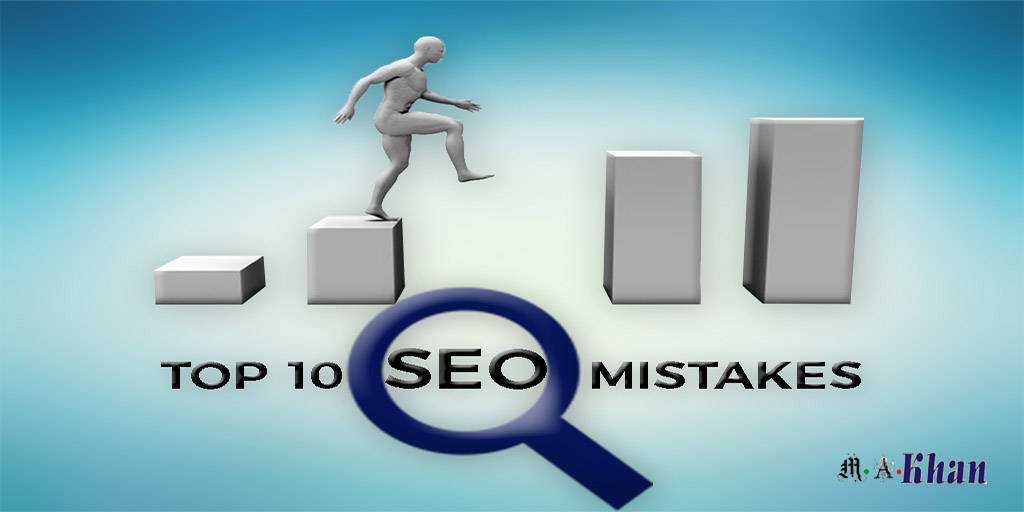Are you struggling to get your website to rank higher on search engines? Don’t worry, we’ve got you covered! In this guide, we’ll walk you through the 10 common SEO mistakes that many people make and how to avoid them.
With simple and actionable tips, you’ll be on your way to improving your website’s search engine visibility and driving more organic traffic. Let’s dive in and discover the secrets to boosting your online presence!
Search engine optimization has turned into the key to the achievement of any site in this day and age, yet at the same time, there are individuals who disregard the SEO part of their site and endeavor to either locate some less expensive approaches to streamline their site or self-upgrade their site without knowing about SEO.
At MAKhan, we do an intensive investigation of our customer’s site and its rival’s site, and afterward perform research to discover the title, description, keywords, H1 labels, and content in the particular customer’s site.
I need to list 10 brilliant principles that could be taken after, with a specific end goal to keep away from basic SEO oversights to advance the sites:
- Maintain a strategic distance from a severely surrounded site title:
- Try not to utilize copy/lacking the substance of the page:
- Check all your backlinks (Poor backlinks/fewer backlinks are hurtful):
- Check all your inner connections:
- Utilize header labels in the substance properly:
- Utilize Keywords appropriately:
- Make an appropriate XML sitemap for the site:
- Utilize the tag legitimately:
- Try not to utilize excessively of JavaScript excessively where it isn’t required:
- Have persistence:
- Conclusion – How to Avoid 10 Common SEO Mistakes
Maintain a strategic distance from a severely surrounded site title:
Site title plays an imperative part in deciding the rank of a page via web indexes. On the off chance that your site has an unimportant title, at that point your website page will be given less relevance by a search engine.
In the wake of checking your page, the web index coordinates your content with the title and keywords of your page, so it is vital to deal with a couple of things while planning the title.
- One ought never to utilize a catchphrase more than once in the title.
- The title tag ought to be surrounded by 10 – 60 characters, with no unique characters.
- Continuously put the critical watchwords in the title, complying with the lead of leftward i.e., the initial word is greatest, the second will be second best, and so on.
- The title ought to dependably identify with the substance of the page, its Meta description, and Meta keywords, and ought to be decipherable by the client.
- There ought to be a particular title and depiction of each page.
Read Also: Master the Art of Crafting Powerful, Eye-catching Headlines for Your Blog Posts
Try not to utilize copy/lacking the substance of the page:
Never configure copy or terrible content for your website page. Inadequate or Duplicate substance won’t go on without serious consequences via web crawlers, even your sites can be restricted.
Duplicate content is a notorious issue on the web. Therefore, always strive to create unique and engaging content. When your content stands out, people are more likely to connect and interact with you. If you find it challenging to produce original content consistently, consider hiring talented writers who can create quality, one-of-a-kind articles for your website.
Check all your backlinks (Poor backlinks/fewer backlinks are hurtful):
The number of backlinks/incoming connections of a site speaks to its fame. The quantity of backlinks equals the number of votes standing for a specific site or a site page. Google considers backlinks as an imperative factor to decide page rank. Try not to connect to sites that are not applicable to your site, as it won’t benefit you. Continuously connect to a high page-rank site.
Google doesn’t bolster interface trade, so better not embrace it. One way quality backlinks are constantly better for SEO. There are different approaches to expanding the backlinks. The accommodation to Directories and Search Engine Submission is the most straightforward yet capable and results-oriented movement.
Making fascinating web journals and articles is also extremely accommodating to get quality backlinks to your site. The long-range informal communication profiles can likewise be used to convey backlinks to your site.
Check all your inner connections:
Broken inner connections hurt SEO. Continuously approve all your inside connections so that there are no broken connections on your site. Utilizing a comparable grapple message in every one of the connections is likewise not recommended.
Grapple content is the content that is the noticeable piece of a hyperlink; never utilize the same stay message in every one of your connections, like snap here or something which is immaterial to that connection. Stay content connection ought to contain keywords. Utilize hyphenated filenames, yet not long ones – a few hyphens as it were. What’s more, attempt to utilize keywords in the URLs too.
Utilize header labels in the substance properly:
One of the POSITIVE ON-Page SEO Factors is the use of keywords in H1, H2, and H3 labels. We should utilize these labels while keeping in mind the end goal to get the page upgraded. However, the issue with these labels is that they don’t look pleasant, all things considered, in the web programs for h1 and h2 labels are too substantial, and h5 and h6 are too small.
So the general appearance of the page gets mutilated. That is the reason, by and large, individuals disregard them. However, with the coming of templates, it has turned out to be simple for the software engineers to change the progression of the labels, so one can see them in the program with the proper size. Additionally, one ought never to utilize the H1 label more than once on a page.
Utilize Keywords appropriately:
Keywords are the great weapon of your sites, so never overlook them, whether it is keywords in the Meta tag, URL, or Meta description.
Meta Keywords: Never utilize normal Meta keywords on every one of the site pages of your site. It will be screened as copy content channel checks by the Search Engine. The regular run for Keyword in the catchphrase Meta tag is to utilize fewer than 10 words.
Each word in this label MUST show up somewhere in the body content. If not, it can be rebuffed for superfluity. No single word ought to seem more than twice. If not, it might be considered spamming.
Keyword in URL: Often, individuals disregard the best possible use of catchphrases in url, and it is loaded down with superfluous words.
Continuously utilize a fitting portrayal of the page content in the URL, expecting this chain of importance First word is the greatest, the second is the second best, and so on.
Keyword in a description Meta tag: Do not put comparative portrayals for every page. It ought to be one of a kind for every one of the pages and significant to the page content. In a perfect world, it ought to contain fewer than 200 burns.
High Keyword density in body content: Ideally, keyword density ought to be 5-20% (all keywords/total words). Singular word thickness ought to be 1 – 6% (every catchphrase/add up to words).
In any case, on the off chance that you are imagining that utilizing catchphrases wherever will make the page more important than it’s a wrong supposition. Try not to stuff keywords irrationally all over the place.
Make an appropriate XML sitemap for the site:
Sitemaps encourage you to speak with the SE. The site gets filed in different web search tools by an XML sitemap. So, always refresh your sitemap with the goal that your website pages get recorded effectively by the web crawlers.
Utilize the tag legitimately:
In the majority of circumstances, the pictures are ignored in SEO. Long and inane names of the pictures pass on nothing to the web index; attempt to join a few keywords in the picture name with the goal that the internet searcher will show them. Utilize alt tags to depict the pictures. ALT labels ought to contain a description of what the picture is.
It is a naming gadget to interpret your picture into content for web search tools. It likewise interprets your picture into a printed reference for clients with visual impairment. So, utilize the tag painstakingly.
Try not to utilize excessively of JavaScript excessively where it isn’t required:
Use as much perfect HTML code rather than JavaScript code, as the internet searcher couldn’t interpret JavaScript content.
Have persistence:
There is no shortcut to ranking in the top 10 for your selected keywords. Sometimes, even after submitting your sitemap and publishing quality content, Google may list your page as Crawled – Currently Not Indexed. This means Google has seen the page but hasn’t yet added it to search results.
So have patience and remain proactive.
Always publish unique, high-quality content and make sure it’s properly optimized. SEO is an ongoing process—keep updating your content, monitor performance, and ensure Google indexes your pages correctly.
At long last, be careful of those web-promoting firms that give you 100% confirmation of getting the pages ordered. Indeed, even Google says that there is no rush to get 100% streamlining, and the standards to upgrade the site page continue changing, so be cautious and take the suitable step.
Conclusion – How to Avoid 10 Common SEO Mistakes
Congratulations! You’ve now equipped yourself with the knowledge to steer clear of those pesky common SEO mistakes. By implementing these tips, you’ll be well on your way to improving your website’s search engine rankings and driving more traffic. Remember, staying vigilant and regularly checking for these errors will lead to long-term success in the digital world.
Share this valuable information with your friends and fellow website owners to help them avoid these pitfalls too. We’d love to hear your thoughts, so don’t forget to leave your feedback in the comments below. Let’s support each other in our SEO endeavors and watch our websites soar to new heights!






